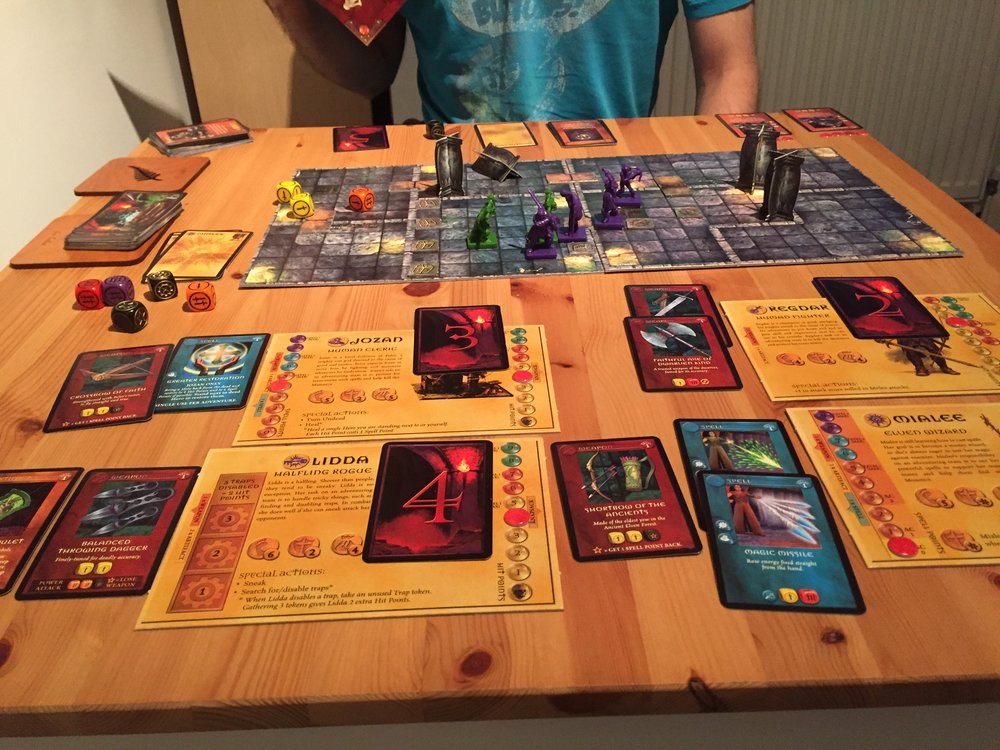My partner and I played the Dungeons and Dragons, but the board game version.
My quick review of this game is that you can play this and have fun, but only if you put the effort in. Much like tabletop D&D, without the enthusiasm, you’re just sitting around the table hitting a goblin with your sword each round. With the enthusiasm, the dungeon master can pull out a rather interesting story and give the cardboard a life.
It’s a cooperative game, for 2-5 players that feels a lot like Dungeons and Dragons. After playing this, you’ll likely wanna throw off the shackles of that rule book, and jump into real D&D. (Where, ironically the rule book is much bigger, but you’re far more free.)

Rules as building blocks
The rule book for this game isn’t very long. It’s intentionally kept manageable in order to be accessible as a family game. You won’t be spending hours reading the rules before you start, like you could when playing the original version. However, that doesn’t mean you’re stuck with just those rules. There are still gaps where they could probably add in more rules (looting a dead goblin, for instance), so we found ourselves making up rules as we went along to fill those gaps.
It’s interesting because it didn’t feel like the game was broken because we had to do that. We could have played entirely within the rules: “looting” isn’t an action that your character can do. It’s not mentioned in the book, so it’s out. That would have been fine. They couldn’t really call themselves a D&D game if the rules really were that ridged though.
There was one occasion where I wanted my wizard to fire her bow through a doorway, where a companion was standing. My partner double checked his rule book (the DM has their own copy, with extra content), and couldn’t find anything about being able to shoot through someone, narrowly avoiding them. So, on the spot, he made up a rule: you can do it, but roll this 50/50 dice too – on success, the arrow hits the goblin, otherwise, it hits your friend.
Having space to make up house rules like this made it feel like real D&D, though I could definitely see it as a criticism of incomplete rules. Being able to make these types of rules feels like you’re building a game together, rather than just playing it. Ownership of these rules brings the player and the game closer together.
Monopoly has this same aspect to it, oddly enough. Go read the rules: you’ll probably find that your household has been playing it differently to the house next door. In our house, we liked to play with fines and taxes going to “free parking” and whoever lands on it first gets the money – pretty sure my dad made it up (or at least, that’s just how his parents played).
There are certainly games where house rules wouldn’t make sense. What would you change about Dixit or Blackjack? But when it’s on the table, I’d say go for it.
Ignore the baggage
The first adventure is a typical one. The sheriff has ventured alone into the old cave system to try and sort out the troublesome goblins. He’s been in there an awful long time though… Thank goodness you four adventurers have turned up, just in time to go and rescue him.
My partner – who insisted on being the dungeon master for this game – has never spent much time with goblins. Not much time with fantasy at all, actually. This was a concern of mine, initially. But he doesn’t know their typical tactics, or motivations. It turns out the DM’s guide doesn’t fill him in on any of this either, so he kinda just had to wing it.
We ended up with some very interesting canon being formed though. When I attempted to loot the first goblin, Tim’s reaction (after finding no looting rules) was to have the goblin corpse turn to dust. A little later a goblin, after his thousand year slumber, materialised out of a whirlwind of dust, and leaped in for the attack.
This isn’t how goblins are supposed to behave. They’re not thousands of years old, and they’re not dust creatures. But they are in this game – they are in Tim’s world. It was incredibly cool! This isn’t the same game as everyone else played. You want normal goblins? Go and player literally any other game. It was truly unique – which is surprising when this game, out of the box, feels a little stiff and railroaded.
One of the take aways for me from this game is that it’s cool to let the players build a world outside of the rule book. A game should somehow encourage imagination. Let the players figure out themselves why something is happening the way it is. Adding in the opportunity of talk about what’s happening in this world makes it very fun.
You’ve two choices when designing your game: write out the whole backstory, and have the players be part of that adventure, or have the players write the whole thing. When the players are writing, they’re more invested.
By the way, if you like the sound of that second option more, you should be playing real Dungeons and Dragons.